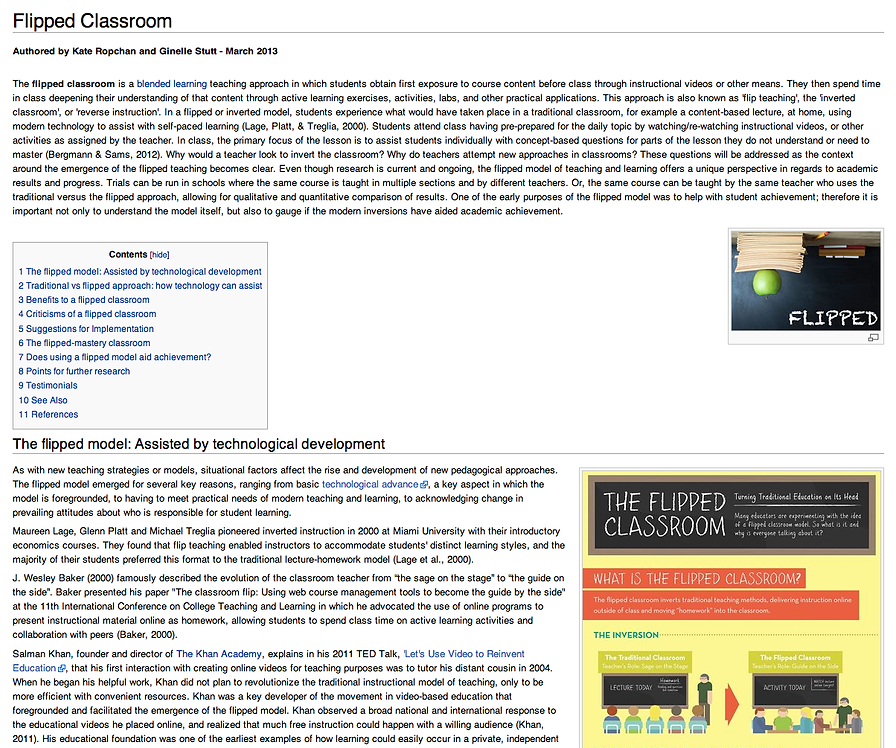
Kate Ropchan's
ePortfolio

My voyage to Master of Educational Technology

Capsizing
Capsizing, when a boat is turned on its side or upside down, is the perfect metaphor for “flipping the classroom”, where the traditional lecture/homework approach to teaching is inverted. With flip teaching, students obtain first exposure to course content before class through instructional videos, then spend class time extending their understanding of that content through active learning exercises, activities, labs, or other practical applications. This instructional approach has both benefits and drawbacks, as I discuss in my ETEC 510 design wiki and ETEC 500 research proposal. I enjoyed the opportunity to research the flipped classroom, as it is a teaching strategy that many of my colleagues are trying out, and I considered transitioning to flip teaching as well. After examining the research, I concluded that flip teaching relies very heavily on lecture-style instruction. For that reason, I have decided to hold off on flipping my classroom and focus on more constructivist teaching methods.
Artifact: Flipped Classroom Design Wiki
In ETEC 510, I had the opportunity to create a wiki entry on a topic of my choice. I immediately thought of the flipped classroom and teamed up with a MET colleague who also shared an interest for this topic. Even though I am teaching in B.C. and she is currently working in Switzerland, we both teach Psychology, and we both had co-workers that were currently initiating flip teaching. Our shared common interests made this one of my most enjoyable group projects, as we were both highly motivated to contribute to our wiki. The fact that we live in time zones that are nine hours apart from one another did not pose any problem because the wiki was very conducive to asynchronous collaboration. I found the wiki creation process to be highly rewarding and am currently looking into ways to use wikis in the classes that I teach.
Researching the flipped classroom provided me with a more thorough understanding of its strengths and weaknesses. From what I have seen in my own school, a flipped approach is more successful in courses like Calculus 12, where students are highly motivated and choosing to take that class, versus Math 8 where a wide range of learners are taking a required course. The main problem my co-workers experienced with flipped teaching in Math 8 is that only about half of the class actually watched the videos, meaning that several students did not receive instruction. It was possible to compensate for this if there were more capable "peer tutors" on hand to explain concepts to students when they got stuck, otherwise the teacher was not able to get around and answer every student's questions. Due to the research that I have conducted and the courses that I teach, I will not be flipping my classroom any time soon.
Artifact: Flipped Classroom Research Proposal
In ETEC 500, I expanded upon my knowledge of the flipped classroom when researching the impact of flip teaching on students' perceptions of learning and academic achievement in a secondary science class. Previous literature on this topic has shown various success rates of a flipped classroom approach on academic performance (Alvarez, 2011; Frederickson, Reed, & Clifford, 2005; Lents & Cifuentes, 2009). Thus there is a need for further research to determine whether flipping the classroom is effective, particularly at the high school level. Additionally, research indicates that many students seem to prefer a face-to-face lesson over watching a video, but they recognize the value of the collaborative learning activities afforded by the inverted instructional approach (Frederickson et al., 2005; Ronchetti, 2010; Strayer, 2012). Thus I have decided not to create instructional videos for my students, but I am trying to utilize more rich learning activities where students have the opportunity to collaboratively build their knowledge.
Designing a research proposal gave me the opportunity to see what it would be like to conduct a research study, which I may decide to pursue in greater detail in the future. Until then, this artifact serves to illustrate my continued pursuit to learn more about the impact of flip teaching.


